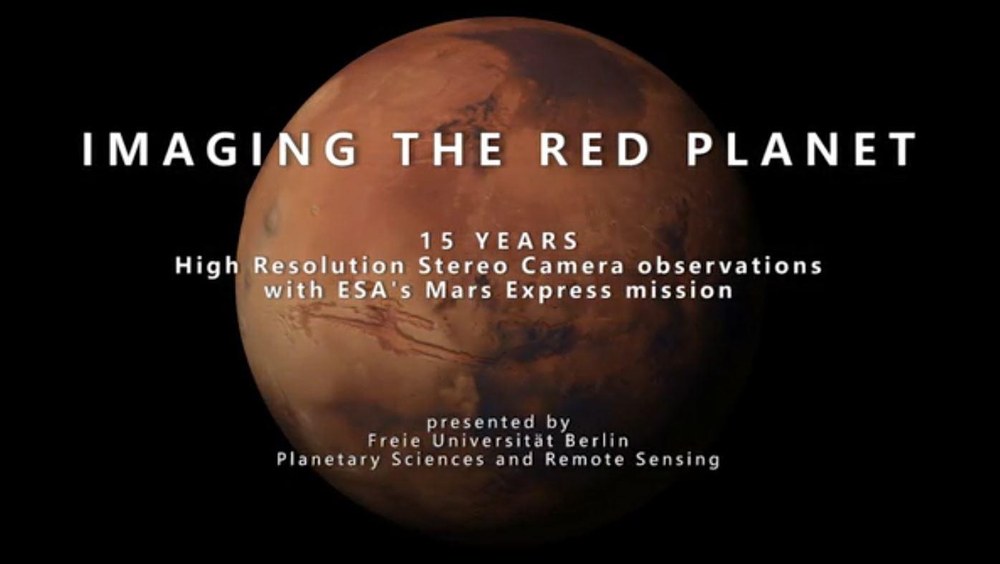15 years of images from DLR's HRSC stereo camera on board ESA's Mars Express spacecraft


Your consent to the storage of data ('cookies') is required for the playback of this video on Quickchannel.com. You can view and change your current data storage settings at any time under privacy.
ESA/DLR/FU Berlin, CC BY-SA 3.0 IGO.

- On 10 January 2004 the High Resolution Stereo Camera (HRSC) on board ESA's Mars Express spacecraft, acquired its first detailed image of the Martian surface.
- The spacecraft completed its 19,000th orbit around Mars on 8 January 2019.
- To date, approximately 360 gigabytes of compressed raw data has been acquired and transmitted to Earth. After 'unpacking' the data packets and performing a first processing step, this has expanded to 5400 gigabytes, which form the basis for further processing into image data suitable for cartography.
- ESA has extended the mission seven times because of its success; it will last until the end of 2022.
- Focus: Space, planetary research
Fifteen years ago, early on the evening of Saturday 10 January 2004, over a dozen scientists crammed into a tiny, somewhat austere room at the German Aerospace Center (Deutsches Zentrum für Luft- und Raumfahrt; DLR) research centre in Berlin Adlershof to stare intently at two monitors. They were awaiting the first images from 'their' experiment, the High Resolution Stereo Camera (HRSC). Just over two weeks earlier, the Mars Express spacecraft, launched by the European Space Agency (ESA), had reached its destination and manoeuvred into a stable, elliptical orbit over the poles of the planet. As planned, the experiments were now set to begin. Despite an initial unsatisfactory test, HRSC showed its full potential during the tenth orbit. Mars Express transmitted razor-sharp high-definition image data with a perfect brightness distribution via ESA's ground stations to the European Space Operations Centre in Darmstadt. In Berlin the images were greeted with boundless enthusiasm. This was the beginning of a success story that has lasted one-and-a-half decades.
HRSC is a German camera experiment developed by DLR and carried on board ESA's Mars Express orbiter; it is operated by the DLR Institute of Planetary Research. The spacecraft has been orbiting Mars since Christmas 2003. This week, on 8 January 2019, the orbiter, dubbed 'MEX' by the scientists and engineers involved in the project, completed its 19,000th orbit of Mars. ESA's first planetary mission is a true 'marathon runner'. In total, the probe has travelled approximately 950 million kilometres around Mars, in addition to its almost 500-million-kilometre journey from Earth to Mars. The total distance travelled is roughly the same as the distance from the Sun to Saturn.
The high-resolution image data, in stereo and colour, form the basis for the global mapping of Mars and the creation of digital terrain models that reveal the planet's topography. HRSC has acquired image data during more than 5000 orbits around Mars and thus provided more data than any other German experiment investigating objects within the Solar System. To date, approximately 360 gigabytes of compressed raw data have been acquired and transmitted to Earth. After 'unpacking' the data packets and putting them through the first stage of processing, the researchers have 5400 gigabytes of data, which form the basis for further processing into image data suitable for cartography.
The images have resulted in an ever-growing collection of spectacular views of the diverse Martian landscape – from image and terrain model mosaics to animations that can be derived from the digital landscape models. The camera has provided coverage of 80 percent of the Martian surface at high resolution (better than 20 metres per pixel). Originally, Mars Express was intended to last only one Martian year, which equates to two Earth years. Due to its success, ESA has already extended the mission seven times, and it is now set to run until the end of 2022. Ralf Jaumann from the DLR Institute of Planetary Research in Berlin-Adlershof is the Principal Investigator for the experiment; the science and engineering team includes 51 co-investigators. Hundreds of scientists worldwide are now working with the data from the experiment. The systematic processing of the camera data is performed at the DLR Institute of Planetary Research. Staff in the Department of Planetary Science and Remote Sensing at the Freie Universität Berlin create the image products that are published monthly.
The German space industry implements a DLR concept for mapping Mars
HRSC, which was developed by DLR in conjunction with German industry, represented, at the time, a completely new camera concept that had never previously been used for planetary mapping. Its unique optics – an Apo-Tessar telescope built by Jena-Optronik GmbH – illuminate nine line sensors positioned transverse to the direction of flight that, due to the forward motion of the orbiter, image the same strip of the Martian surface – like a scanner – working line-by-line, one after the other. In doing so, each sensor images the same area on the surface from a different angle. Back on Earth, the four stereo image strips and the nadir channel, which is oriented perpendicular to Mars and provides the highest image resolution at 10 to 12 metres per pixel, are used to create 3D models of the planet's surface. The remaining four of the nine line sensors are equipped with special colour filters for acquiring multispectral data. The focal plane with the nine sensors forms the heart of the camera and was developed by DLR. Lewicki Microelectronic GmbH built the camera's electronics. Dornier (later Astrium and now Airbus Defence and Space) in Friedrichshafen assembled the complete instrument. The camera system was originally developed for use on the Russian Mars 96 mission, but it was lost shortly after launch on 17 November 1996. The flight spare camera, which is of identical construction, was then used on Mars Express instead – after the incorporation of a number of improvements.
